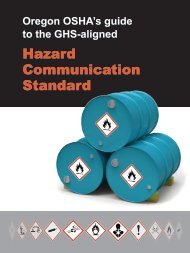Technical Manual - Section 3 (Safety Hazards)
Technical Manual - Section 3 (Safety Hazards)
Technical Manual - Section 3 (Safety Hazards)
Create successful ePaper yourself
Turn your PDF publications into a flip-book with our unique Google optimized e-Paper software.
metallic parts is that the waves are mechanical, so the test<br />
equipment requires three basic components.<br />
@<br />
@<br />
@<br />
Electronic system for generating electrical signal.<br />
Transducer system to convert the electrical signal<br />
into mechanical vibrations and vice versa and to<br />
inject the vibrations into and extract them from the<br />
material.<br />
Electronic system for amplifying, processing and<br />
displaying the return signal.<br />
Very short signal pulses are induced into the material and<br />
waves reflected back from discontinuities are detected during<br />
the "receive" mode. The transmitting and detection can be<br />
done with one transducer or with two separate transducers<br />
(the tandem technique).<br />
Unlike radiography, UT in its basic form does not produce a<br />
permanent record of the examination. However, more recent<br />
versions of UT equipment include automated operation and<br />
electronic recording of the signals.<br />
Ultrasonic techniques can also be used for the detection and<br />
measurement of general material loss such as by corrosion<br />
and erosion. Since wave velocity is constant for a specific<br />
material, the transit time between the initial pulse and the<br />
back reflection is a measure of the travel distance and the<br />
thickness.<br />
DETECTION PROBABILITIES AND FLAW<br />
SIZING<br />
The implementation of NDE (nondestructive examination)<br />
results for structural integrity and safety assessment involves<br />
a detailed consideration of two separate but interrelated<br />
factors.<br />
@<br />
@<br />
Detecting the discontinuity.<br />
Identifying the nature of the discontinuity and<br />
determining its size.<br />
Much of the available information on detection and sizing<br />
capabilities has been developed for aircraft and nuclear power<br />
applications. This kind of information is very specific to the<br />
nature of the flaw, the material, and the details of the test<br />
technique, and direct transference to other situations is not<br />
always warranted.<br />
The overall reliability of NDE is obviously an important<br />
factor in a safety and hazard assessment. Failing to detect or<br />
undersizing existing discontinuities reduces the safety margin<br />
while oversizing errors can result in unnecessary and<br />
expensive outages. High reliability results from a<br />
combination of factors.<br />
@<br />
@<br />
Validated procedures, equipment and test personnel.<br />
Utilization of diverse methods and techniques.<br />
@<br />
Application of redundancy by repetitive and<br />
independent tests.<br />
Finally, it is useful to note that safety assessment depends on<br />
evaluating the "largest flaw that may be missed, not the<br />
smallest one that can be found."<br />
III:3-8
















